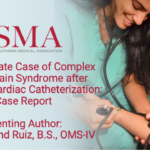Abstract | November 6, 2020
An Unfortunate Case of Complex Regional Pain Syndrome after Transradial Cardiac Catheterization: A Case Report
Learning Objectives
- Describe the clinical presentation of Complex Regional Pain Syndrome and identify one uncommon etiology.
- Discuss the importance of early diagnosis and treatment to prevent potential disability.
Introduction: Complex regional pain syndrome (CRPS) is a rare debilitating condition, of a neurological nature, affecting commonly the distal extremities bypassing dermatomal distributions. CRPS is characterized by pain out of proportion of the affected area with associated swelling, decreased range of motion (ROM), vasomotor involvement, and skin involvement, muscle wasting, and contractures.
Case Presentation: This is the case of a 55-year-old female with past medical history of hypertension who underwent cardiac catheterization on 11/18/2019 after presenting symptoms of intermittent pressure-like chest pain upon exertion, radiating to the left arm with an abnormal ECG. Six weeks status-post (s/p) trans- radial cardiac catheterization, patient returned to the hospital with gradual onset and progressive lateral shoulder and medial forearm pain, and hypersensitivity since the procedure. Physical exam showed tenderness over the right shoulder, limited ROM on shoulder abduction, elbow pronation, and hand dorsiflexion. Contraction of second, third, and fourth digits on right hand was present. Patient experienced allodynia in right upper lateral shoulder and medial forearm. She had negative venous doppler ultrasound, wrist x-ray, and MRI of right shoulder unremarkable for nerve compression. Differential diagnoses were osteoarthritis, radiculopathy, brachial plexopathy, deep vein thrombosis, all which were ruled out by imaging.
Final Diagnosis: Due to clinical presentation and negative imaging, the diagnosis of CRPS was made.
Management and Outcome: Patient was given pain management with anti-inflammatory, nerve pain medications and opioid. Occupational Therapy was limited, and a splint was recommended to prevent contracture. A Stellate ganglion block was performed without improvement. Early intervention has shown to improve the outcome and decrease disability. With only five reported cases of CRPS s/p trans-radial cardiac catheterization as of 2019, early diagnosis is important for prompt management. As in this case, a six-week delay in intervention had a detrimental effect on patient’s prognosis, likely resulting in long-term disability.

